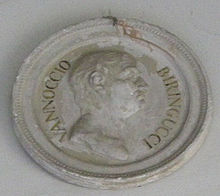Vanoccio Biringuccio
| Vannoccio Biringuccio | |
|---|---|

Vannoccio Biringuccio as depicted in the Specola Museum in Florence.
|
|
| Born |
c. 1480 Siena |
| Died | c. 1539 |
| Nationality | Italian |
| Engineering career | |
| Significant advance | metallurgist |
Vannoccio Biringuccio, sometimes spelt Vannocio Biringuccio (c. 1480 – c. 1539), was an Italian metallurgist. He is best known for his manual on metalworking, De la pirotechnia, published posthumously in 1540.
Biringuccio was born in Siena as the son of Paolo Biringuccio, presumably an architect, and Lucrezia di Bartolommeo Biringuccio. He was baptised on October 20, 1480.
He was a follower of Pandolfo Petrucci, the head of the powerful Petrucci family. Pandolfo employed him as a metallurgist. When Pandolfo died, Biringuccio remained tied to the Petrucci family, being employed by Pandolfo's son Borghese Petrucci. However, the uprising of 1515 forced Borghese to flee from Siena, taking Biringuccio with him. Biringuccio traveled about Italy, and visited Sicily in 1517.
In 1523 Pope Clement VII caused the reinstatement of the Petrucci family, and along with them Biringuccio was able to return from exile. In 1524 he was granted a monopoly on the production of saltpeter across all of Siena. However, this was short lived—in 1526, the people of Siena revolted and threw the Petrucci family out again. The family made an attempt (aided by Biringuccio) to regain Siena by force, but it failed.
In 1530, Siena entered a more peaceful phase, and Biringuccio returned. He was a Senator of the city in January and February 1531, and took part in various projects.
In 1536, he was offered a job in Rome by the Church, and in 1538 he became head of the papal foundry, and director of munitions.
His exact place and date of death is unknown; all that is known is that a document dated 1539 mentions his death.
Biringuccio is considered by some as the father of the foundry industry as De la pirotechnia is the first printed account of proper foundry practice. It also gives details of mining practice, the extraction and refining of numerous metals, alloys such as brass, and compounds used in foundries and explosives. It preceded the printing of De re metallica by Georgius Agricola by 14 years.
...
Wikipedia
